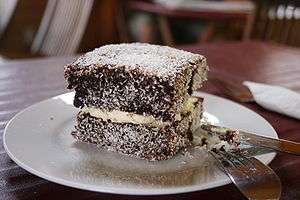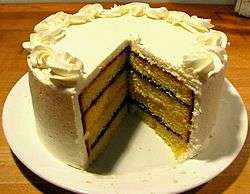Lamington
|
A cream-filled lamington | |
| Type | Sponge cake |
|---|---|
| Place of origin | Brisbane |
| Main ingredients | Icing, desiccated coconut, sugar |
|
| |
A lamington is an Australian cake, made from squares of sponge cake coated in an outer layer of chocolate (or sometimes raspberry) sauce and rolled in desiccated coconut. The thin mixture is absorbed into the outside of the sponge cake and left to set, giving the cake a distinctive texture. A common variation has a layer of cream or strawberry jam between two lamington halves.[1]
Origins
Maurice French, an emeritus professor of history at the University of Southern Queensland, who has examined the question in depth,[2] believes that it is certain that lamingtons were named after either Lord Lamington, who served as Governor of Queensland from 1896 to 1901, or his wife, Lady Lamington.[3][4] Most sources incline to the former option.[5][6][7] The earliest known reference to the naming of the lamington from June 1927, links the cake to Lord Lamington.[8]
The identity of the recipe's inventor has also been debated. Most stories attribute its creation to Lord Lamington's chef, the French born Armand Galland, who was called upon at short notice to feed unexpected guests. Using only the limited ingredients available, Galland cut up some left-over French vanilla sponge cake baked the day before, dipped the slices in chocolate and set them in coconut. Impressed by Galland's creation, Lamington's guests were said to have later asked for the recipe. This version of events is supported by Lady Lamington's memoirs.[9] Coconut was not widely used in European cooking at that time, but was known to Galland whose wife was from Tahiti where coconut was a common ingredient. Another possible inventor is Amy Schauer, cooking instructor at Brisbane's Central College from 1897 to 1938.
One such account suggests that the lamington was first served in Toowoomba, when Lord Lamington took his entourage to Harlaxton House to escape the steamy heat of Brisbane,[10] whereas another claims that it was created by Galland at Queensland's Government House in Brisbane during the busy period leading up to Federation in 1901. A further alternative claim is that Lord Lamington's cook, presumably Galland, accidentally dropped a block of sponge cake into a dish of chocolate. It was later discovered that desiccated coconut, sprinkled over the top, made the cakes more appealing.[11]
The first known mention of "Lamington cake" appears in an 1896 newspaper account of a "Lamington Function" at Laidley in Queensland. The event was in honour of Lord Lamington (although it appears he did not attend) and also featured "Lamington Tea", "Lamington Soup etc, so, in the absence of any description of the cake, the name of the cake might signify nothing more than the name of the event.[12] A 1900 recipe for Lamington Cakes has been found in the Queensland Country Life newspaper.[13] While the recipe originated Queensland, it spread quickly, appearing in a Sydney newspaper in 1901[14] and a New Zealand newspaper in 1902.[15] However, none of these recipes indicate the creator of the recipe nor the reason for its name.
Modern day

Lamingtons remain a popular snack across Australia and New Zealand and Friday, 21 July 2006, was designated as National Lamington Day in Australia.[16] Lamingtons are often sold at fundraisers for schools or charity groups, known as "lamington drives".[17]
Variants
A similar but smaller sized confection is known in South Africa as ystervarkies (porcupines), while in Cleveland, Ohio, they are called coconut bars.[18] Another similar dessert known as čupavci is also eaten in Croatia.
See also
References
- ↑ Michael Symons (1984). One Continuous Picnic: A History of Eating in Australia. Penguin Books Australia. ISBN 978-0-14-007167-2.
- ↑ Maurice French (2013). The Lamington Enigma: A Survey of the Evidence. Tabletop Publishing. ISBN 978-0-9874322-0-9.
- ↑ Veenhuyzen, Max (15 May 2014). "Lamingtons – provenance unproven but tastiness unquestioned". The Guardian. ISSN 0261-3077. Retrieved 21 April 2016.
- ↑ Martell, Ally (25 July 2013). "A slice of the action - the lamington demands recognition". The Australian. Retrieved 10 September 2016.
- ↑ Darra Goldstein; Sidney Mintz; Michael Krondl; Laura Mason (2015). The Oxford Companion to Sugar and Sweets. Oxford University Press. pp. 34–. ISBN 978-0-19-931339-6. Cite uses deprecated parameter
|coauthors=(help) - ↑ Alan Davidson (21 August 2014). The Oxford Companion to Food. OUP Oxford. pp. 456–. ISBN 978-0-19-104072-6.
- ↑ Barbara Santich (2012). Bold Palates: Australia's Gastronomic Heritage. Wakefield Press. pp. 203–. ISBN 978-1-74305-094-1.
- ↑ "Some Special Recipes.". The Sydney Mail. NSW: National Library of Australia. 29 June 1927. p. 37. Retrieved 1 February 2015.
- ↑ Cosima Marriner, 'Galland attempt to please a Lady takes the Cake' The Saturday Age (6 June 2009): 9.
- ↑ http://www.fast-ed.com.au/a-brief-history-of-lamingtons/
- ↑ "Lamington—The Oz 'National Dish'". Ozwords. Australian National Dictionary Centre. May 1999. Retrieved 11 October 2006.
- ↑ "Notes on the "Lamington Function.".". Queensland Times, Ipswich Herald and General Advertiser. Qld.: National Library of Australia. 28 July 1896. p. 3. Retrieved 17 January 2015.
- ↑ "Useful Recipes.". Queensland Country Life. Qld.: National Library of Australia. 17 December 1900. p. 29. Retrieved 18 April 2014.
- ↑ "THE LADIES' PAGE.". Sydney Mail and New South Wales Advertiser. NSW: National Library of Australia. 12 October 1901. p. 938. Retrieved 17 January 2015.
- ↑ "THE WOMAN'S WORLD". New Zealand Herald. 27 August 1902. p. 3. Retrieved 17 January 2015.
- ↑ "Australians celebrate National Lamington Day". www.radioaustralia.net.au. ABC Radio Australia. 20 July 2012. Retrieved 10 September 2016.
- ↑ Joan Hughes (1989). Australian words and their origins. Oxford University Press. ISBN 978-0-19-553087-2.
- ↑ Veenhuyzen, Max (15 May 2014). "Lamingtons – provenance unproven but tastiness unquestioned". The Guardian. ISSN 0261-3077. Retrieved 21 April 2016.
Further reading
- French, Maurice (2013), The Lamington enigma : a survey of the evidence, Toowoomba Tabletop Publishing, ISBN 978-0-9874322-0-9

